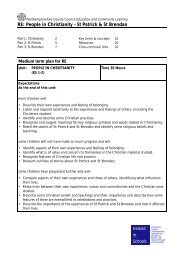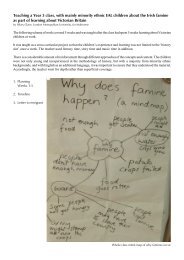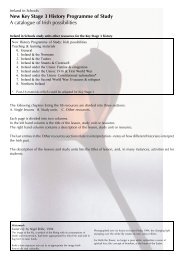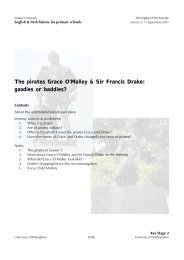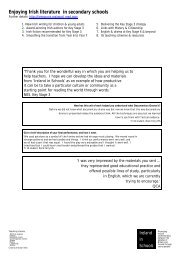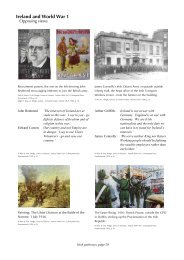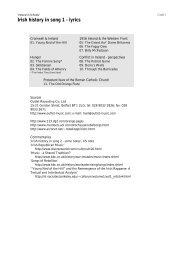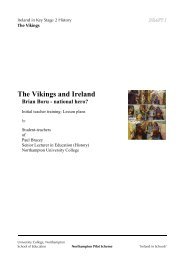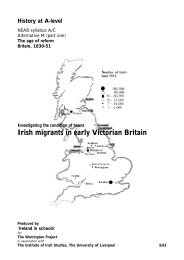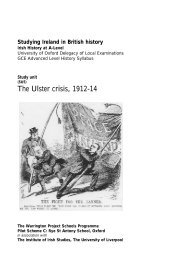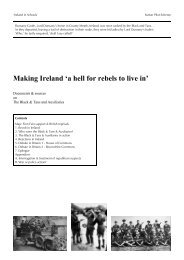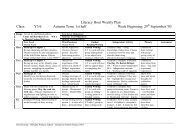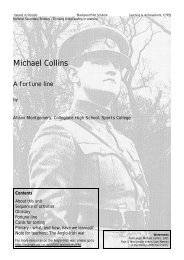Booklet 4 The Irish Famine - Ireland in Schools
Booklet 4 The Irish Famine - Ireland in Schools
Booklet 4 The Irish Famine - Ireland in Schools
Create successful ePaper yourself
Turn your PDF publications into a flip-book with our unique Google optimized e-Paper software.
<strong>Ireland</strong> <strong>in</strong> <strong>Schools</strong> Nott<strong>in</strong>gham Pilot Scheme School of Education, U. of Nott<strong>in</strong>gham<br />
<strong>Ireland</strong> 1801-1921<br />
Lesson plans, worksheets & other resources<br />
Unit 2<br />
<strong>Booklet</strong> 4 <strong>The</strong> <strong>Irish</strong> <strong>Fam<strong>in</strong>e</strong><br />
Lesson 9 What caused <strong>Ireland</strong> to suffer between 1845 & 1850?<br />
Lesson 10 How did different groups respond to the <strong>Irish</strong> <strong>Fam<strong>in</strong>e</strong>?<br />
Lesson 11 How did the Nationalists react to the <strong>Fam<strong>in</strong>e</strong>?<br />
Lesson 12 What effect did the Great <strong>Fam<strong>in</strong>e</strong> have on the <strong>Irish</strong>?<br />
By<br />
Gary Hillyard<br />
Ashfield School, Kirkby-<strong>in</strong>-Ashfield
Topic title: <strong>The</strong> Great <strong>Fam<strong>in</strong>e</strong><br />
Lesson 9<br />
Lesson 10<br />
Lesson 11<br />
Lesson 12<br />
Homework<br />
Lesson title<br />
What caused <strong>Ireland</strong> to suffer<br />
between 1845 and 1850?<br />
Aims:<br />
•To exam<strong>in</strong>e the causes of the<br />
Great <strong>Fam<strong>in</strong>e</strong>.<br />
•To analyse picture sources for<br />
mean<strong>in</strong>g.<br />
Lesson title<br />
How did different groups<br />
respond to the Great <strong>Fam<strong>in</strong>e</strong>?<br />
Aims:<br />
•To exam<strong>in</strong>e how the British<br />
Government reacted.<br />
•To look at the activities of<br />
the Nationalist movement.<br />
Lesson title<br />
How did the nationalists react<br />
to the fam<strong>in</strong>e?<br />
Aims:<br />
•To exam<strong>in</strong>e the nationalist<br />
reaction.<br />
•To assess whether or not that<br />
was a cont<strong>in</strong>uation of previous<br />
aims and methods.<br />
Lesson title<br />
What effect did the Great<br />
<strong>Fam<strong>in</strong>e</strong> have on the <strong>Irish</strong>?<br />
Aims:<br />
•To exam<strong>in</strong>e the short and<br />
long-term impact of the <strong>Irish</strong><br />
<strong>Fam<strong>in</strong>e</strong>.<br />
Starter<br />
Read through the Graphic<br />
story of the <strong>Irish</strong> fam<strong>in</strong>e –<br />
pick out the causes, the<br />
short-term impact and the<br />
long term effects.<br />
Starter<br />
Place the 5 sources around<br />
the room. Assign small groups<br />
to each source. <strong>The</strong>y have to<br />
write how it makes them feel<br />
around the edge. <strong>The</strong>n rotate<br />
the groups until all groups<br />
have seen all of the sources.<br />
Starter<br />
Get students to fill out the<br />
section of their worksheet on<br />
what they th<strong>in</strong>k the reaction<br />
of the nationalists would be.<br />
Feedback suggestions.<br />
Starter<br />
Start with a freeze-frame.<br />
Ask for volunteers. <strong>The</strong>y are<br />
to create a mock image of<br />
what they see <strong>in</strong> the picture.<br />
<strong>The</strong> rest of the class can then<br />
ask them questions and they<br />
have to answer <strong>in</strong> character.<br />
Ma<strong>in</strong> Activities<br />
Give out the source sheet. Students study the<br />
sources and use them to add <strong>in</strong>formation to the five<br />
boxes on the worksheet.<br />
<strong>The</strong>n they must create a concept map – they draw<br />
l<strong>in</strong>ks between the five causes expla<strong>in</strong><strong>in</strong>g how they<br />
worked together to cause the fam<strong>in</strong>e.<br />
Ma<strong>in</strong> Activities<br />
Feedback on the words used. Hopefully, there will<br />
be a sense of sympathy. This should later be<br />
juxtaposed to the actual actions taken by the<br />
British government.<br />
Work your way through the problem solv<strong>in</strong>g<br />
exercise. In each scenario students have to decide<br />
what the English would have done at that time.<br />
Ma<strong>in</strong> Activities<br />
Use pages 64-66 of the textbook to fill out the<br />
f<strong>in</strong>al section of the worksheet.<br />
Ma<strong>in</strong> Activities<br />
Go through the PowerPo<strong>in</strong>t. Students have to<br />
decide whether the <strong>in</strong>formation is a short-term or<br />
long-term impact on the <strong>Irish</strong>. Some of the<br />
<strong>in</strong>formation is deliberately ambiguous.<br />
Students must write this <strong>in</strong>to an essay for<br />
homework.<br />
Lesson 10 – Read through the extract from Under the Hawthorn Tree and the review of it and the Horrible Histories picture.<br />
Lesson 12 – Write up essay. Use the markscheme on the follow<strong>in</strong>g page to mark it.<br />
Plenary<br />
Show the OHT of <strong>The</strong><br />
<strong>Fam<strong>in</strong>e</strong> by Rois<strong>in</strong> Hambly.<br />
How does it make them<br />
feel? How does the<br />
narrator feel?<br />
Plenary<br />
Feedback on the correct<br />
answers.<br />
Stress that the British<br />
government spent around £8<br />
million on relief for the poor<br />
dur<strong>in</strong>g the fam<strong>in</strong>e.<br />
Plenary<br />
Discuss how the aims and<br />
methods compare to those<br />
used dur<strong>in</strong>g the<br />
Emancipation and Repeal<br />
crises.<br />
Plenary<br />
Just a m<strong>in</strong>ute – students<br />
have to talk about a topic<br />
without repetition,<br />
hesitation etc.<br />
Use the topics:<br />
<strong>The</strong> Great <strong>Fam<strong>in</strong>e</strong><br />
British Responses.<br />
Materials<br />
•Graphic History of the <strong>Fam<strong>in</strong>e</strong>. 1<br />
•w/s Causes of the Great <strong>Fam<strong>in</strong>e</strong><br />
Sources<br />
•OHT – ‘<strong>The</strong> <strong>Fam<strong>in</strong>e</strong>’ by Rois<strong>in</strong><br />
Hambly.<br />
•w/s <strong>The</strong> causes of the Great<br />
<strong>Fam<strong>in</strong>e</strong><br />
Materials<br />
•5 Sources<br />
•w/s Responses to the Great<br />
<strong>Fam<strong>in</strong>e</strong>.<br />
•PPT – Response problem solv<strong>in</strong>g.<br />
•Homework sources<br />
Under the Hawthorn Tree 2 -<br />
extract and review<br />
‘<strong>Fam<strong>in</strong>e</strong> Farm’ from Horrible<br />
Histories .3<br />
Materials<br />
•w/s <strong>Irish</strong> Nationalist response to<br />
the Great <strong>Fam<strong>in</strong>e</strong>.<br />
•Textbook<br />
Materials<br />
•Freeze-frame image<br />
•PPT – Impact of the <strong>Irish</strong> fam<strong>in</strong>e.<br />
•w/s What effect did the Great<br />
<strong>Fam<strong>in</strong>e</strong> have on the <strong>Irish</strong>?<br />
•Christ<strong>in</strong>e K<strong>in</strong>ealy, ‘<strong>The</strong> <strong>Fam<strong>in</strong>e</strong>’. 4<br />
•Sean Lang, ‘<strong>The</strong> Poor Laws and the<br />
<strong>Irish</strong> <strong>Fam<strong>in</strong>e</strong>’. 5<br />
1 by M. Llywelyn & M. Scott, Element, 1996, 1-85230-627-0, ch 10; 2 by Marita Conlon-McKenna, O’Brien Press, 0-86278-206-6, pp 21-5; 3 Horrible Histories Collection 57: <strong>The</strong> Irate <strong>Irish</strong> by Terry<br />
Deary, Eaglemoss, 2005; 4 Modern History Review, September 1995, pp 18-21; 5 Modern History Review, April 2004, pp 20-1.<br />
Hillyard, <strong>Ireland</strong> 1800-1921: L 9, 10, 11 & 12, 2
PowerPo<strong>in</strong>t overview: lesson 9<br />
What caused <strong>Ireland</strong> to suffer<br />
between 1845 and 1850?<br />
Aims<br />
• To exam<strong>in</strong>e the causes of the Great<br />
<strong>Fam<strong>in</strong>e</strong>.<br />
• To analyse picture evidence for<br />
mean<strong>in</strong>g.<br />
<strong>The</strong> Graphic Story – what are the causes,<br />
the short term and long term effects of<br />
the <strong>Fam<strong>in</strong>e</strong>?<br />
See below for text of ‘<strong>The</strong> <strong>Fam<strong>in</strong>e</strong>’.<br />
Hillyard, <strong>Ireland</strong> 1800-1921: L 9, 10, 11 & 12, 3
Causes of the Great <strong>Fam<strong>in</strong>e</strong> Lessons 9 w/s 1<br />
Source 1<br />
Population of <strong>Ireland</strong><br />
1801 5.2 million<br />
1821 6.8 million<br />
1841 8.2 million<br />
Source 2<br />
Population growth was higher <strong>in</strong> some parts of <strong>Ireland</strong> than others, putt<strong>in</strong>g great<br />
pressure on land. A common practice, especially <strong>in</strong> the West, was for tenants to<br />
divide their land among their sons. Sub-division created many small farms <strong>in</strong> <strong>Ireland</strong><br />
as the sons themselves also sub-divided land. Many thousands of families thus had<br />
to exist on smaller and smaller plots of land.<br />
Source 3<br />
<strong>The</strong> potato blight, a fungal disease which rots the potato <strong>in</strong> the ground, struck<br />
<strong>Ireland</strong> <strong>in</strong> September 1845, spread<strong>in</strong>g rapidly <strong>in</strong> an exceptionally wet autumn, and<br />
becom<strong>in</strong>g more widespread <strong>in</strong> 1846…Epidemics of typhus <strong>in</strong> 1847 and cholera <strong>in</strong> 1849<br />
aggravated the situation, ravag<strong>in</strong>g a population already weakened by hunger.<br />
Source 4<br />
For about a century and a half, the potato has been the only food of the peasantry<br />
of <strong>Ireland</strong>. A very limited portion of land, a few days labour, and a small amount of<br />
manure will create a stock upon which a family may exist for twelve months…Nearly<br />
every soil sill produce potatoes; they have been seen grow<strong>in</strong>g from almost barren<br />
rock on the side of a mounta<strong>in</strong>, and <strong>in</strong> the bog where the foot would s<strong>in</strong>k many <strong>in</strong>ches<br />
<strong>in</strong> the soil.<br />
Source 5<br />
<strong>The</strong> quantity of food consumed by the labour<strong>in</strong>g poor<br />
Area Gender Breakfast D<strong>in</strong>ner<br />
Limerick<br />
Men<br />
Women<br />
4½ lbs potatoes; 1 p<strong>in</strong>t skimmed milk<br />
<strong>The</strong> same<br />
<strong>The</strong> same<br />
<strong>The</strong> same<br />
Thurles<br />
Men<br />
Women<br />
3-5 lbs potatoes, 1-2 p<strong>in</strong>ts skimmed milk<br />
3-3½ lbs potatoes, 1 p<strong>in</strong>t skimmed milk<br />
<strong>The</strong> same<br />
<strong>The</strong> same<br />
Hillyard, <strong>Ireland</strong> 1800-1921: L 9, 10, 11 & 12, 4
Small farms<br />
Lesson 9 - w/s 2<br />
<strong>The</strong> staple crop was potato<br />
Population<br />
Causes of the Great <strong>Fam<strong>in</strong>e</strong><br />
Causes of the Great <strong>Fam<strong>in</strong>e</strong><br />
People ate lots of potatoes<br />
Disease - human & plant<br />
Hillyard, <strong>Ireland</strong> 1800-1921: L 9, 10, 11 & 12, 5
<strong>The</strong> <strong>Fam<strong>in</strong>e</strong> by Rois<strong>in</strong> Hambly<br />
Lesson 9 - OHT<br />
In the Spr<strong>in</strong>g of ’45<br />
I planted my potato crop,<br />
But when I dug them up <strong>in</strong> W<strong>in</strong>ter<br />
<strong>The</strong>y were black and brown from rot.<br />
<strong>The</strong>re were seven <strong>in</strong> my family,<br />
Four children under five,<br />
I had to f<strong>in</strong>d some food for them,<br />
To keep them all alive.<br />
It wasn’t too bad to start with,<br />
But by Autumn ’47,<br />
Two members of my family<br />
Had died and gone to Heaven.<br />
That W<strong>in</strong>ter it was long and cold<br />
And every th<strong>in</strong>g was bare,<br />
<strong>The</strong>n when my lovely wife passed on<br />
I thought it so unfair.<br />
My family were now so th<strong>in</strong>,<br />
<strong>The</strong>ir faces were so hollow<br />
<strong>The</strong>y decided to emigrate<br />
But foolishly I didn’t follow.<br />
I saw a soldier sell<strong>in</strong>g corn,<br />
No one was around,<br />
I took this opportunity<br />
To knock him to the ground.<br />
I robbed him of his food and money<br />
And quickly ran away,<br />
But sadly I was caught and killed<br />
And left there to decay.<br />
Hillyard, <strong>Ireland</strong> 1800-1921: L 9, 10, 11 & 12, 6
PowerPo<strong>in</strong>t overview: lesson 10<br />
How did different groups respond<br />
to the <strong>Fam<strong>in</strong>e</strong>?<br />
Aims<br />
•To exam<strong>in</strong>e how the British government<br />
reacted.<br />
•To look at the activities of the<br />
Nationalist movement.<br />
Responses to the Great <strong>Fam<strong>in</strong>e</strong><br />
Scenarios 1 & 2 - see below for texts.<br />
Responses to the Great <strong>Fam<strong>in</strong>e</strong><br />
Scenarios 5 & 6 - see below for texts.<br />
Responses to the Great <strong>Fam<strong>in</strong>e</strong><br />
Scenarios 3 & 4, correct answers - see<br />
below for texts.<br />
Task 1:<br />
You are go<strong>in</strong>g to be given one m<strong>in</strong>ute at<br />
each of the sources spread around the<br />
room. Around the outside of the picture<br />
you must write words or phrases to<br />
describe how it makes you feel.<br />
Responses to the Great <strong>Fam<strong>in</strong>e</strong><br />
Scenarios 3 & 4 - see below for texts.<br />
Responses to the Great <strong>Fam<strong>in</strong>e</strong><br />
Scenarios 1 & 2, correct answers - see<br />
below for texts.<br />
Responses to the Great <strong>Fam<strong>in</strong>e</strong><br />
Scenarios 5 & 6, correct answers - see<br />
below for texts.<br />
Homework:<br />
Read through the extract from Under the<br />
Hawthorn Tree and the review of it, as<br />
well as the Horrible Histories section. Use<br />
these to answer the questions on the<br />
worksheet.<br />
Hillyard, <strong>Ireland</strong> 1800-1921: L 9, 10, 11 & 12, 7
<strong>The</strong> <strong>Fam<strong>in</strong>e</strong> - 5 sources Lesson 10<br />
Hillyard, <strong>Ireland</strong> 1800-1921: L 9, 10, 11 & 12, 8
Responses to the Great <strong>Fam<strong>in</strong>e</strong><br />
Lesson 10 - w/s 1 - for use with follow<strong>in</strong>g Ppt<br />
Scenario Your chosen option Reasons for your choice Correct answer &<br />
reason/explanation<br />
1. <strong>The</strong> <strong>Fam<strong>in</strong>e</strong> began <strong>in</strong> 1845. By<br />
July 1846 the position of the<br />
<strong>Irish</strong> was so bad. <strong>The</strong> potato<br />
crop had failed and the <strong>Irish</strong><br />
were runn<strong>in</strong>g out of food. Peel, a<br />
Conservative, was the Prime<br />
M<strong>in</strong>ister of the Great Brita<strong>in</strong>.<br />
In his position should he…<br />
2. <strong>The</strong>re is still a shortage of<br />
foodstuffs. Some corn is dripp<strong>in</strong>g<br />
through from the ma<strong>in</strong>land but it<br />
is not enough for the <strong>Irish</strong> to<br />
survive.<br />
If you were Peel do you…<br />
3. <strong>The</strong> corn is still not solv<strong>in</strong>g the<br />
problem, although it is mak<strong>in</strong>g life<br />
slightly better. <strong>The</strong> <strong>Irish</strong> poor<br />
still had to work for landlords.<br />
If you were Peel…<br />
Hillyard, <strong>Ireland</strong> 1800-1921: L 9, 10, 11 & 12, 9
Scenario Your chosen option Reasons for your choice Correct answer &<br />
reason/explanation<br />
4. <strong>The</strong> price of gra<strong>in</strong> is <strong>in</strong>creas<strong>in</strong>g<br />
massively. <strong>The</strong> <strong>Irish</strong> Boards of<br />
Work cont<strong>in</strong>ue to employ men to<br />
carry out public works schemes<br />
such as road repairs and road<br />
build<strong>in</strong>g. By 1847 750,000 men<br />
worked for the Boards.<br />
<strong>The</strong> Boards of Work had a<br />
decision to make, though…<br />
5. <strong>The</strong> Labour Act was passed <strong>in</strong><br />
1846 which further worked on<br />
landlords to provide work,<br />
punish<strong>in</strong>g them if they did not by<br />
forc<strong>in</strong>g them to pay a 'labour<br />
rate'. However, by the spr<strong>in</strong>g of<br />
1847 the situation was worsen<strong>in</strong>g.<br />
If you were Russell (PM after<br />
Peel) would you…<br />
6. From late 1847 the Poor Relief<br />
system (allow<strong>in</strong>g the poorest<br />
people to go to workhouses to be<br />
looked after) was fail<strong>in</strong>g.<br />
c.200,000 people were sheltered<br />
<strong>in</strong> workhouses, double the number<br />
they should have held. Conditions<br />
were appall<strong>in</strong>g and the unions<br />
which ran them were bankrupt.<br />
Should Russell…<br />
Hillyard, <strong>Ireland</strong> 1800-1921: L 9, 10, 11 & 12, 10
Responses to the <strong>Fam<strong>in</strong>e</strong> - problem-solv<strong>in</strong>g<br />
Lesson 10 - Ppt for w/s 1- slides<br />
Scenario 1<br />
<strong>The</strong> <strong>Fam<strong>in</strong>e</strong> began <strong>in</strong> 1845. By July 1846 the<br />
position of the <strong>Irish</strong> was so bad. <strong>The</strong> potato<br />
crop had failed and the <strong>Irish</strong> were runn<strong>in</strong>g<br />
out of food. Peel, a Conservative, was the<br />
Prime M<strong>in</strong>ister of the Great Brita<strong>in</strong>. In his<br />
position should he…<br />
a) Send across new potato seeds <strong>in</strong> order for<br />
<strong>Irish</strong> farmers to grow new potato crops?<br />
b) Overturn the Corn Laws which taxed<br />
foreign gra<strong>in</strong> and made it more expensive?<br />
c) Do noth<strong>in</strong>g – the problem has only been<br />
go<strong>in</strong>g on for a few months and may well just<br />
die down?<br />
Scenario 3<br />
<strong>The</strong> corn is still not solv<strong>in</strong>g the problem,<br />
although it is mak<strong>in</strong>g life slightly better.<br />
<strong>The</strong> <strong>Irish</strong> poor still had to work for<br />
landlords.<br />
If you were Peel…<br />
a) Would you try to encourage the landlords<br />
to farm the land themselves?<br />
b)Would you encourage the landlords to<br />
organise together and raise money for those<br />
effected and to provide work?<br />
c) Would you tell the landlords to sell up<br />
while they still can?<br />
Scenario 5<br />
<strong>The</strong> Labour Act was passed <strong>in</strong> 1846 which<br />
further worked on landlords to provide work,<br />
punish<strong>in</strong>g them if they did not by forc<strong>in</strong>g<br />
them to pay a ‘labour rate’. However, by the<br />
spr<strong>in</strong>g of 1847 the situation was worsen<strong>in</strong>g.<br />
If you were Russell (PM after Peel) would<br />
you…<br />
a) Beg<strong>in</strong> freely distribut<strong>in</strong>g food through<br />
soup kitchens, like the Quakers had done?<br />
b) Double the ‘labour rate’ – f<strong>in</strong>d work for<br />
the poor or go bankrupt?<br />
c) Do noth<strong>in</strong>g. You have already done<br />
enough?<br />
Scenario 2<br />
<strong>The</strong>re is still a shortage of foodstuffs.<br />
Some corn is dripp<strong>in</strong>g through from the<br />
ma<strong>in</strong>land but it is not enough for the <strong>Irish</strong> to<br />
survive. If you were Peel do you…<br />
a) Try and import more gra<strong>in</strong> from abroad,<br />
particularly America. This can then be sold<br />
cheaply?<br />
b) Ask Parliament for extra cash to give<br />
money to the fam<strong>in</strong>e victims?<br />
c) Encourage the <strong>Irish</strong> to ration the food<br />
that they eat to ensure that there is enough<br />
corn to go round?<br />
Scenario 4<br />
<strong>The</strong> price of gra<strong>in</strong> is <strong>in</strong>creas<strong>in</strong>g massively.<br />
<strong>The</strong> <strong>Irish</strong> Boards of Work cont<strong>in</strong>ue to<br />
employ men to carry out public works<br />
schemes such as road repairs and road<br />
build<strong>in</strong>g. By 1847 750,000 men worked for<br />
the Boards.<br />
<strong>The</strong> Boards of Work had a decision to make,<br />
though…<br />
a) Should they pay them at subsistence level<br />
– enough money to get by?<br />
b) Should they pay them above subsistence<br />
level allow<strong>in</strong>g them to prosper?<br />
c) Should they pay them below subsistence<br />
level otherwise everyone would want to work<br />
for the Boards?<br />
Scenario 6<br />
From late 1847 the Poor Relief system<br />
(allow<strong>in</strong>g the poorest people to go to<br />
workhouses to be looked after) was fail<strong>in</strong>g.<br />
c.200,000 people were sheltered <strong>in</strong><br />
workhouses, double the number they should<br />
have held. Conditions were appall<strong>in</strong>g and the<br />
unions which ran them were bankrupt.<br />
Should Russell…<br />
a) Build more workhouses to cope with the<br />
problem?<br />
b) Beg<strong>in</strong> giv<strong>in</strong>g relief to the poor still liv<strong>in</strong>g<br />
at home – outdoor relief?<br />
c) Expand the public works schemes?<br />
Hillyard, <strong>Ireland</strong> 1800-1921: L 9, 10, 11 & 12, 11
Scenario 1<br />
Correct Answer<br />
b) Overturn the Corn Laws which taxed<br />
foreign gra<strong>in</strong> and made it more expensive.<br />
This would make gra<strong>in</strong> much cheaper for the<br />
<strong>Irish</strong> to import.<br />
Scenario 3<br />
Correct Answer<br />
b) Would you encourage the landlords to<br />
organise together and raise money for those<br />
effected and to provide work?<br />
<strong>The</strong> government believed <strong>in</strong> the policy of<br />
laissez-faire – that it should not <strong>in</strong>terfere <strong>in</strong><br />
local affairs. Hence, its reliance on<br />
landlords to organise relief.<br />
Scenario 5<br />
Correct Answer<br />
a) Beg<strong>in</strong> freely distribut<strong>in</strong>g food through<br />
soup kitchens, like the Quakers had done.<br />
Volunteer and religious groups like the<br />
Quakers had already begun distribut<strong>in</strong>g food<br />
<strong>in</strong> this way. Once aga<strong>in</strong>, the scheme was<br />
chosen because of the laissez-faire<br />
approach - it was paid for through local<br />
rates. By August, 3 million + were fed this<br />
way. Scheme ended <strong>in</strong> September 1847.<br />
Scenario 2<br />
Correct Answer<br />
a) Try and import more gra<strong>in</strong> from abroad,<br />
particularly America. This can then be sold<br />
cheaply.<br />
This would make more corn readily available<br />
to the <strong>Irish</strong> and would put less pressure on<br />
the British to provide corn.<br />
Scenario 4<br />
Correct Answer<br />
c) Should they pay them below subsistence<br />
level otherwise everyone would want to work<br />
for the Boards?<br />
<strong>The</strong> Government were unwill<strong>in</strong>g to push<br />
public works schemes as they felt that they<br />
should not be used to allow <strong>in</strong>dividuals to<br />
prosper. Hence, the low wage ensured the<br />
poor did not rely on these schemes to<br />
improve their lot.<br />
Scenario 6<br />
Correct Answer<br />
b) Beg<strong>in</strong> giv<strong>in</strong>g relief to the poor still liv<strong>in</strong>g<br />
at home – outdoor relief.<br />
Around 800,000 people were given aid <strong>in</strong><br />
their home. Build<strong>in</strong>g workhouses would have<br />
been too much <strong>in</strong>volvement and public work<br />
schemes were dropped <strong>in</strong> 1847.<br />
Hillyard, <strong>Ireland</strong> 1800-1921: L 9, 10, 11 & 12, 12
<strong>Fam<strong>in</strong>e</strong> - results & sources<br />
Lesson 10 - w/s 2 - Homework<br />
Questions<br />
Read through the extract, the review and the picture from Horrible Histories.<br />
1. List the results of the <strong>Fam<strong>in</strong>e</strong> on people’s lives<br />
2. How useful are these sources as evidence for historians study<strong>in</strong>g the potato<br />
fam<strong>in</strong>e of 1845-50<br />
Hillyard, <strong>Ireland</strong> 1800-1921: L 9, 10, 11 & 12, 13
Under the Hawthorn Tree - extract<br />
by Marita Conlon-McKenna, O'Brien Press, 0-86278-206-6, pp 21-5<br />
Lesson 10 - Homework<br />
<strong>The</strong>y pushed <strong>in</strong> the door. Mother was doz<strong>in</strong>g with Bridget <strong>in</strong><br />
the chair near the fire. She looked tired and they could tell she<br />
had been cry<strong>in</strong>g.<br />
Quiet as mice, they reheated some leftover oatmeal and<br />
water. <strong>The</strong>y were all tired out, and glad to fall <strong>in</strong>to bed. With<br />
arms and shoulders ach<strong>in</strong>g, they scarcely had time to notice the<br />
normal rumbl<strong>in</strong>g hunger pa<strong>in</strong>s that came before sleep.<br />
At some time dur<strong>in</strong>g the night they became aware of their<br />
mother’s sobs and of Bridget cough<strong>in</strong>g and try<strong>in</strong>g to breathe.<br />
Michael came and lay down <strong>in</strong> the bed beside the girls. <strong>The</strong>y<br />
held hands and prayed - every prayer they had ever learned.<br />
‘God help us, please help us, God,’ they whispered.<br />
No one slept. It was the early hours of the morn<strong>in</strong>g before<br />
the cough<strong>in</strong>g stopped. <strong>The</strong>n there was a sudden silence.<br />
Mother was kiss<strong>in</strong>g the baby’s face and each little f<strong>in</strong>ger one<br />
by one.<br />
‘God let the sun come up soon and let this terrible night<br />
end,’ the children begged.<br />
Suddenly they became aware of their mother’s silence. <strong>The</strong>y<br />
got up and went over to her. Large tears slid down her cheeks.<br />
‘She’s gone. My own little darl<strong>in</strong>g is gone.’ Peggy started to<br />
cry. ‘I want Bridget back,’ she wailed. ‘I want her.’<br />
‘It’s all right, pet,’ assured Mother. ‘She was too weak to<br />
stay <strong>in</strong> this hard world any longer. Look at her. Isn’t she a<br />
grand little girl, now she’s at rest.’<br />
<strong>The</strong> baby lay still, as if she were just doz<strong>in</strong>g. Mother told<br />
them to kiss her, and one by one they kissed the soft cheek and<br />
forehead of Bridget, the little sister they hardly knew.<br />
Mother seemed strangely calm and made them go back to<br />
bed. ‘At first light, Michael, you must run to Dan Coll<strong>in</strong>s and<br />
ask him to get Father Doyle. I’ll just sit and m<strong>in</strong>d my darl<strong>in</strong>g<br />
girl for a little while yet.’<br />
Later, Michael set off, his face pale and his eyes redrimmed.<br />
<strong>The</strong> chill of the early morn<strong>in</strong>g made him shiver as he<br />
pulled his light jacket around him.<br />
Mother had heated some water and with a cloth she gently<br />
washed Bridget, and brushed and brushed the soft blond curls.<br />
Eily pulled the old wooden chest from under Mother and<br />
Father’s bed. As <strong>in</strong>structed, she opened it. <strong>The</strong>re wasn’t that<br />
much <strong>in</strong> it, so she soon found the lace christen<strong>in</strong>g robe which<br />
her great-grandmother had made. <strong>The</strong> lace was yellow and old.<br />
It was only ten months s<strong>in</strong>ce Bridget had worn the robe -<br />
before, but her little body was so th<strong>in</strong> and wasted it still fitted<br />
her. Dressed <strong>in</strong> it she looked like a little pale angel, though<br />
Eily couldn’t help but remember a porcela<strong>in</strong> French doll she<br />
had seen <strong>in</strong> a shop w<strong>in</strong>dow <strong>in</strong> the town once. It stood stiff <strong>in</strong> a<br />
white lace dress with a starched petticoat and long curl<strong>in</strong>g real<br />
hair. How she had wanted to hold and have that doll. Now she<br />
felt the same long<strong>in</strong>g, but much worse. She ached to hold<br />
Bridget and never let her go.<br />
Michael came home. <strong>The</strong>y all had a sup of milk and tidied<br />
themselves and the cottage as best they could. Dan Coll<strong>in</strong>s<br />
would get the priest. Father Doyle was a nice man - he and<br />
Father were very friendly and sometimes he would drop <strong>in</strong> for<br />
a chat and a bit of company. Father used to say that be<strong>in</strong>g a<br />
priest was grand, but it was a lonely life Mid-morn<strong>in</strong>g they<br />
were all surprised when Dan Coll<strong>in</strong>s and his wife Kitty arrived.<br />
Kitty ran straight to Mother and kissed her. <strong>The</strong>ir eyes were<br />
full of tears and unspoken words.<br />
‘Margaret, we are so sorry. Poor little Bridget,’ whispered<br />
Kitty.<br />
Dan Coll<strong>in</strong>s cleared his throat and shifted uneasily. ‘<strong>The</strong>re<br />
is more bad news, God spare us. Father Doyle is gone down<br />
with the sickness himself and will not be able to bury the wee<br />
lassie. Already <strong>in</strong> the village a few have died of the sickness -<br />
Seamus Fadden, the coff<strong>in</strong> maker, be<strong>in</strong>g one - so there are no<br />
proper funerals ...‘ He stopped.<br />
Mother let out a high wail<strong>in</strong>g cry. ‘What will become of us,<br />
what are we to do?’ <strong>The</strong> air hung heavy.<br />
‘We’ll bury her decently <strong>in</strong> her own place,’ said Dan.<br />
<strong>The</strong> three children stared at Mother, wait<strong>in</strong>g for her reply.<br />
She nodded her head silently.<br />
‘Under the hawthorn tree <strong>in</strong> the back field,’ she whispered.<br />
‘<strong>The</strong> children always played there and its blossom will shelter<br />
her now.’<br />
Dan motioned to Michael and they left the cottage and<br />
disappeared up to the field carry<strong>in</strong>g a spade.<br />
‘We’ve no coff<strong>in</strong>;’ said Mother hoarsely.<br />
Kitty looked around the cottage and begged Eily to help<br />
her. Eily cleared her throat. ‘What about us<strong>in</strong>g grandmother’s<br />
wooden chest?’<br />
Kitty and Eily pulled it out from under the old bed and<br />
lifted it onto the blanket. Mother walked over and nodded<br />
silently. Kitty began to take out the family treasures and lay<br />
them to one side.<br />
Kitty and Mother started to get everyth<strong>in</strong>g ready. Eily and<br />
Peggy, sens<strong>in</strong>g they were not wanted, ran outside and pulled<br />
bluebells and wild flowers. <strong>The</strong>y sucked <strong>in</strong> deep breaths of air<br />
to try and calm their hearts.<br />
Dan came back down the field and went <strong>in</strong>side. In a few<br />
m<strong>in</strong>utes the three adults emerged, Kitty hold<strong>in</strong>g Mother’s arm<br />
and Dan carry<strong>in</strong>g the carved wooden chest.<br />
A light breeze blew and the blossom bowed and waved <strong>in</strong><br />
welcome. <strong>The</strong>re was a clear blue sky. A family of bluetits sat<br />
on the branch of the tree, help<strong>in</strong>g to keep vigil.<br />
Dan and Kitty led them <strong>in</strong> the prayers and they all<br />
remembered the words of Jesus, ‘Suffer the little children to<br />
come unto me’. <strong>The</strong>y prayed too that they would ‘meet aga<strong>in</strong><br />
<strong>in</strong> Paradise’.<br />
Eily and Michael gently placed the flowers beside the chest.<br />
Peggy clung to Mother as huge sobs racked her body. Mother<br />
stroked her hair. <strong>The</strong>y all sang a favourite hymn of Father<br />
Doyle’s, then Kitty led them back to the house. She had<br />
brought some tea and made a mug for the adults. She made<br />
Mother sit down near the fire as she warmed some leftover<br />
potato cakes.<br />
For the next few days, Mother stayed <strong>in</strong> her shift with the<br />
shawl wrapped around her, and barely bothered to do anyth<strong>in</strong>g.<br />
Hillyard, <strong>Ireland</strong> 1800-1921: L 9, 10, 11 & 12, 14
Eily and Michael fetched the water, swept out the cottage and<br />
searched for food. <strong>The</strong>y wished that Father would come back.<br />
Eily was scared. How long would it last?<br />
Under the Hawthorn Tree - review<br />
by S. Churney, K<strong>in</strong>g David High School, Liverpool<br />
Lesson 10 - Homework<br />
<strong>The</strong> Great <strong>Fam<strong>in</strong>e</strong> of <strong>Ireland</strong> is arguably the most tragic and<br />
horrific fam<strong>in</strong>e ever to strike <strong>in</strong> the post. It was both one of the<br />
most lethal fam<strong>in</strong>es <strong>in</strong> modern history and o watershed <strong>in</strong> the<br />
development of modern <strong>Ireland</strong>. It has <strong>in</strong> itself created a<br />
longlast<strong>in</strong>g effect <strong>in</strong> the world of <strong>Ireland</strong>, even to this day,<br />
kill<strong>in</strong>g more than one million people of its population. <strong>The</strong><br />
number of souls decreased considerably throughout the<br />
disastrous years of labour and hardship and has never risen<br />
s<strong>in</strong>ce this dreadful <strong>in</strong>cident.<br />
<strong>The</strong> unbalanced diet of potatoes and milk had long been the<br />
ma<strong>in</strong> food <strong>in</strong> <strong>Ireland</strong>. It kept people strong and healthy,<br />
work<strong>in</strong>g <strong>in</strong> the fresh air and eat<strong>in</strong>g this nutritious food.<br />
Another reason for plant<strong>in</strong>g potatoes was that with the<br />
subdivision of land regime, potatoes could be grown <strong>in</strong> small<br />
amounts of land. An acre of potatoes would have fed a family<br />
of five for a year, whereas on acre of wheat would feed one or<br />
two people. However, it was <strong>in</strong>tensely dangerous to depend on<br />
one type of food crop. <strong>The</strong> crop could fail if o particular year<br />
was damp and frigid. Food shortages were not unique to<br />
<strong>Ireland</strong> after 1845, although fam<strong>in</strong>e was.<br />
In the summer of 1845, a greatly hazardous disease struck the<br />
country as a surprise - POTATO BLIGHT! <strong>The</strong> potato failure<br />
impacted a country that was familiar with periodic shortages.<br />
From then on, ord<strong>in</strong>ary people's lives were turned upside down<br />
<strong>in</strong> the struggle to survive without their desired food- potato.<br />
<strong>Fam<strong>in</strong>e</strong> hod arrived, which would hount the people <strong>in</strong>volved<br />
for years to come. Hope for the future was all they had left to<br />
keep on liv<strong>in</strong>g.<br />
‘Under the Hawthorn Tree’ written by Morita Conlon-<br />
McKenna is a deeply mov<strong>in</strong>g story of the children of the<br />
fam<strong>in</strong>e, express<strong>in</strong>g the hope, courage and suffer<strong>in</strong>g of young<br />
children subjected to the jeopardy of the fam<strong>in</strong>e.<br />
<strong>The</strong> three children <strong>in</strong> the novel, Eily, Michael and Peggy<br />
symbolise the exhilaration and optimism with regard to the<br />
fam<strong>in</strong>e and the courage children and even adults took to<br />
survive <strong>in</strong> the dire shortage of food <strong>in</strong> their country.<br />
Eily, Michael and Peggy ore left alone, surrounded by disaster.<br />
In danger of be<strong>in</strong>g sent to the workhouse, they escape, and set<br />
out on a long and challeng<strong>in</strong>g journey to f<strong>in</strong>d the great-aunts<br />
they have heard about <strong>in</strong> their mother's stories, their mother<br />
hav<strong>in</strong>g gone !n ca desperate search of their father.<br />
<strong>The</strong> story demonstrates how the <strong>Fam<strong>in</strong>e</strong> profoundly affected<br />
many aspects of <strong>Irish</strong> life <strong>in</strong>clud<strong>in</strong>g the separation of family life<br />
and the deaths, which affected the psychological m<strong>in</strong>ds of the<br />
<strong>Irish</strong>.<br />
<strong>The</strong> ‘Hawthorn Tree’ also represents the hope of a better life<br />
and is <strong>in</strong> contrast to the disastrous blight of the potatoes.<br />
Whenever this Hawthorn tree is described <strong>in</strong> the book, a<br />
miracle happens of the children's disbelief.<br />
Throughout the book many important aspects of the fam<strong>in</strong>e<br />
come up to play a vital port with<strong>in</strong> the book and I feel it is<br />
important to mention them <strong>in</strong> the act of writ<strong>in</strong>g my essay.<br />
On pages 44-47, a threaten<strong>in</strong>g feel<strong>in</strong>g comes to the children<br />
when the landlord of their house threatens to evict them from<br />
it, as their mother has gone <strong>in</strong> search of their father, feel<strong>in</strong>g it<br />
best to leave them beh<strong>in</strong>d.<br />
‘<strong>The</strong>re is no work for anyone now. I am ordered to check all<br />
the cottages and send those to the workhouse that hove no<br />
means of keep<strong>in</strong>g themselves ... if she [their mother] has<br />
disappeared you can't stay on your own, and will have to make<br />
ready for the journey.’<br />
Many <strong>Irish</strong> families suffered eviction throughout the course of<br />
the fam<strong>in</strong>e. <strong>The</strong>se evictions led to further suffer<strong>in</strong>g among the<br />
poor and the starv<strong>in</strong>g. <strong>The</strong> quote from the book above<br />
exemplifies this po<strong>in</strong>t as the reader immediately sympathises<br />
with the children hav<strong>in</strong>g to leave their home for the<br />
workhouse. It also describes how cruel and callous landlords<br />
were to those <strong>in</strong> need. <strong>The</strong> <strong>in</strong>discrim<strong>in</strong>ate evictions that<br />
<strong>in</strong>tensified after 1847 were a recurrent grievance by tenants,<br />
although proprietors blamed evictions on the high level of poor<br />
rate. Briefly, poor rate was the money the <strong>Irish</strong> had to pay to<br />
stay <strong>in</strong> their house. It comes from the Poor low that was<br />
<strong>in</strong>troduced <strong>in</strong> 1838. Relief was only provided, <strong>in</strong> <strong>Ireland</strong>,<br />
with<strong>in</strong> the conf<strong>in</strong>es of a workhouse. <strong>The</strong> differences between<br />
the Poor Low <strong>in</strong> England and the one <strong>in</strong> <strong>Ireland</strong> made it clear<br />
that the poverty <strong>in</strong> <strong>Ireland</strong> was to be treated more harshly than<br />
elsewhere. Inevitably this attitude shaped responses dur<strong>in</strong>g the<br />
<strong>Fam<strong>in</strong>e</strong>.<br />
Workhouses ore another issue raised with<strong>in</strong> the book as the<br />
children are sent to them by their landlord, forc<strong>in</strong>g them out of<br />
their childhood village. Chapter five entitled ‘<strong>The</strong> Road to the<br />
Workhouse’ describes the poor who went to the workhouse.<br />
<strong>The</strong>y are portrayed <strong>in</strong> a depress<strong>in</strong>g and disease stricken way,<br />
express<strong>in</strong>g some people ‘so weak they could hardly walk.’ It<br />
was true that the ill and the dy<strong>in</strong>g were sent to the workhouse<br />
<strong>in</strong> order to work for food. However, <strong>in</strong> some cases it was too<br />
late. Until the fam<strong>in</strong>e, people avoided the workhouses as much<br />
as they could. However when the fam<strong>in</strong>e did arrive, they had<br />
Hillyard, <strong>Ireland</strong> 1800-1921: L 9, 10, 11 & 12, 15
no choice. By January 1847, there were 111,000 people <strong>in</strong> the<br />
workhouse built to accommodate 100, 000. <strong>The</strong>se numbers<br />
describe the overcrowd<strong>in</strong>g of the place and this just added to<br />
the problems of disease. <strong>Fam<strong>in</strong>e</strong> fever became widespread and<br />
more people died of the spread<strong>in</strong>g of this disease than of<br />
hunger. I feel that from the <strong>in</strong>formation above, the suffer<strong>in</strong>g<br />
and hardship of the <strong>Irish</strong> was immense and more should hove<br />
been done to save them. Landlords ought to have been more<br />
considerate with the poor <strong>Irish</strong> and let them stay with<strong>in</strong> their<br />
own environment of their house.<br />
<strong>The</strong> Quakers gave money to the local people to set up soup<br />
kitchens where free or cheap food was given to the hungry<br />
people. Soup kitchens run by such charities saved many lives<br />
dur<strong>in</strong>g the fam<strong>in</strong>e. Chapter Seven of the book describes such<br />
kitchens from a child's po<strong>in</strong>t of view.<br />
‘Eily could not believe the crowds when they reached the<br />
village. Hundreds of ragged starv<strong>in</strong>g people thronged the small<br />
ma<strong>in</strong> street. <strong>The</strong>y queued desperate for food.’ This describes<br />
the amount of starv<strong>in</strong>g people who come from all parts of the<br />
area to soothe their hunger. It must have been terrible to watch<br />
and experience this occurrence, as the poor depended on this<br />
kitchen to survive their life.<br />
‘<strong>The</strong> faces- the faces- she would never forget them. <strong>The</strong>y all<br />
hod the some look. <strong>The</strong> cheeks were sunken, the eyes wide and<br />
star<strong>in</strong>g with deep circles underneath, the lips narrow and tight,<br />
and <strong>in</strong> some the sk<strong>in</strong> had a yellow t<strong>in</strong>ge.’ This vividly expla<strong>in</strong>s<br />
the appearance of the poor, mak<strong>in</strong>g them out to be near<br />
skeletons. ‘<strong>The</strong>y all had the some look’ conveys a feel<strong>in</strong>g of a<br />
diseased and afflictive atmosphere with<strong>in</strong> the kitchen.<br />
<strong>The</strong> landlords did not wish to encourage the use of these soup<br />
kitchens, because they had to pay for them, so they made them<br />
as unattractive as possible. This is evident <strong>in</strong> the chapter:<br />
‘This must be hell, thought Eily, for once terrified’<br />
Throughout the book, ‘yellow meal’ is described frequently.<br />
This meal was bought by the Prime M<strong>in</strong>ister, Sir Robert Peel<br />
for £100,000 and was the common name for the Indian maize.<br />
Its orig<strong>in</strong>al plant<strong>in</strong>g was done <strong>in</strong> America and he had bought<br />
it to <strong>Ireland</strong>. Many people disliked the maize and called it<br />
‘Peel's Brimstone’ To prevent starvation they were forced to eat<br />
it.<br />
Fortunately for the children, their dangerous and tir<strong>in</strong>g journey<br />
had not been wasted as they found their Great Aunts, Nano and<br />
lens. <strong>The</strong>ir hope and optimism kept their will power go<strong>in</strong>g,<br />
until their greatest feel<strong>in</strong>gs came to life when they saw their<br />
aunts. However not oil stories of the fam<strong>in</strong>e ended up as<br />
contented and fortunate as this, <strong>in</strong>tact, some cases proved quite<br />
the opposite. Weak government, parsimonious adm<strong>in</strong>istrators,<br />
entrenched f<strong>in</strong>ancial <strong>in</strong>terests; anti-Catholic, anti-poor and<br />
anti-<strong>Irish</strong> sentiments produced a particularly lethal<br />
comb<strong>in</strong>ation of misguided <strong>in</strong>tervention and <strong>in</strong>judicious non<strong>in</strong>tervention.<br />
<strong>The</strong> immediate consequence was the unnecessary<br />
deaths of over one million people.<br />
I thoroughly appreciated read<strong>in</strong>g and analys<strong>in</strong>g the book, as it<br />
has expanded and widened my m<strong>in</strong>d to the suffer<strong>in</strong>g humanity<br />
caused by horrify<strong>in</strong>g, <strong>in</strong>tolerable fam<strong>in</strong>e. <strong>The</strong> long-term legacy<br />
of the <strong>Fam<strong>in</strong>e</strong> not only changed <strong>Ireland</strong>, but also cont<strong>in</strong>ued to<br />
<strong>in</strong>fluence British politics after the passage of 150 years.<br />
<strong>The</strong> ‘soup’ was a k<strong>in</strong>d of porridge called ‘stirabout’ and each<br />
person was to get one pound per day. In general, these soup<br />
kitchens worked well.<br />
<strong>The</strong> thirteenth chapter- ‘Peggy's Fever’- outl<strong>in</strong>es the common<br />
disease which was around <strong>in</strong> <strong>Ireland</strong> ‘<strong>Fam<strong>in</strong>e</strong> Fever.’ This<br />
fever broke out among the people who were weakened by<br />
hunger. One of the children <strong>in</strong> the story, Peggy, catches this<br />
awful disease whilst on journey try<strong>in</strong>g to f<strong>in</strong>d her aunts. ‘She<br />
touched Peggy's forehead. It was burn<strong>in</strong>g. <strong>The</strong> sk<strong>in</strong> on her<br />
shoulders and legs and everywhere was hot to touch. She was<br />
burn<strong>in</strong>g up with a fever.’This dist<strong>in</strong>ctly describes the common<br />
effects of the fever, burn<strong>in</strong>g up everywhere and ‘tossed and<br />
turned and sometimes cried out <strong>in</strong> pa<strong>in</strong>’ <strong>The</strong> fever was<br />
prevalent among the weakened and dy<strong>in</strong>g <strong>Irish</strong> and was the<br />
consequence of the tremendous hunger.<br />
Hillyard, <strong>Ireland</strong> 1800-1921: L 9, 10, 11 & 12, 16
Lesson 10 - Homework<br />
Horrible Histories Collection 57: <strong>The</strong> Irate <strong>Irish</strong> by Terry Deary, Eaglemoss, 2005<br />
Hillyard, <strong>Ireland</strong> 1800-1921: L 9, 10, 11 & 12, 17
<strong>Irish</strong> Nationalist response to the Great <strong>Fam<strong>in</strong>e</strong> Lesson 11 - w/s 1<br />
What do you th<strong>in</strong>k the reaction of <strong>Irish</strong> Nationalists<br />
would have been to the British response to the <strong>Fam<strong>in</strong>e</strong>?<br />
<strong>The</strong> actual reaction.<br />
Young <strong>Ireland</strong> Rebellion<br />
Aims:<br />
Methods:<br />
Tenant right movement<br />
Aims:<br />
Methods:<br />
Hillyard, <strong>Ireland</strong> 1800-1921: L 9, 10, 11 & 12, 18
A potato d<strong>in</strong>ner, 28 February 1846<br />
Lesson 12 - freeze-frame- Ppt<br />
Hillyard, <strong>Ireland</strong> 1800-1921: L 9, 10, 11 & 12, 19
PowerPo<strong>in</strong>t overview: lesson 12<br />
What effect did the Great <strong>Fam<strong>in</strong>e</strong><br />
have on the <strong>Irish</strong>?<br />
Aims<br />
•To exam<strong>in</strong>e the short and long-term impact<br />
of the <strong>Irish</strong> fam<strong>in</strong>e.<br />
Land<br />
•Cottiers (small land<br />
owners) were<br />
destroyed and their<br />
population fell<br />
dramatically.<br />
•c.200,000 smaller<br />
farms were lost.<br />
•10% of the old<br />
landlord class went<br />
bankrupt.<br />
•Encumbered Estates<br />
Act was passed <strong>in</strong><br />
1849 to speed up the<br />
sale of land.<br />
•1850s – c.3,000<br />
estates sold.<br />
•But – most were<br />
brought by<br />
speculators or<br />
exist<strong>in</strong>g members of<br />
the landlord class.<br />
Population<br />
•c.1 million men,<br />
women and children<br />
died between<br />
1845-50.<br />
•<strong>Irish</strong> population<br />
decl<strong>in</strong>ed from c.8<br />
million <strong>in</strong> 1841 to<br />
c.6m <strong>in</strong> 1851.<br />
•By 1900 the <strong>Irish</strong><br />
population was ½ the<br />
size it was <strong>in</strong> 1845.<br />
Farm<strong>in</strong>g & liv<strong>in</strong>g<br />
standards<br />
•<strong>The</strong>re was less<br />
concentration on<br />
potato farm<strong>in</strong>g and<br />
more concentration<br />
on dairy and<br />
export<strong>in</strong>g cattle.<br />
•Liv<strong>in</strong>g standards<br />
improved because<br />
wages <strong>in</strong>creased.<br />
•Hous<strong>in</strong>g standards<br />
improved as did<br />
literacy – due to<br />
urbanisation.<br />
•<strong>The</strong> m-c farmer<br />
became the centre<br />
of <strong>Irish</strong> countryside<br />
– there was a 77%<br />
<strong>in</strong>crease <strong>in</strong> farmers’<br />
<strong>in</strong>come and many<br />
farmers got the vote<br />
<strong>in</strong> 1850.<br />
Hillyard, <strong>Ireland</strong> 1800-1921: L 9, 10, 11 & 12, 20
Emigration<br />
•1815-45 – 1.5 million<br />
emigrated.<br />
•1845-50 – 1.5 million<br />
people emigrated.<br />
•1850-1910 – 4.5-5<br />
million emigrated.<br />
•¼ went to England and<br />
Scotland; majority<br />
went to America.<br />
•Before the fam<strong>in</strong>e, it<br />
was ma<strong>in</strong>ly s<strong>in</strong>gle,<br />
landless men who<br />
emigrated.<br />
•Early years of the<br />
<strong>Fam<strong>in</strong>e</strong> – ma<strong>in</strong>ly<br />
cottiers and<br />
labourers, plus some<br />
richer people<br />
emigrated.<br />
•After 1850 it was only<br />
smallholders and<br />
labourers. Whole<br />
families now went too.<br />
•Emigration was hard.<br />
Use the <strong>in</strong>formation you have gathered<br />
over the last four lessons and the<br />
articles to plan and write an answer to<br />
the question:<br />
What effect did the Great <strong>Fam<strong>in</strong>e</strong> have<br />
on the <strong>Irish</strong>?<br />
Just a m<strong>in</strong>ute…<br />
<strong>The</strong> aim is to speak about the topic given<br />
to you by your teacher for 1 m<strong>in</strong>ute<br />
without hesitat<strong>in</strong>g, repeat<strong>in</strong>g or<br />
diverg<strong>in</strong>g.<br />
Hillyard, <strong>Ireland</strong> 1800-1921: L 9, 10, 11 & 12, 21
What effect did the Great <strong>Fam<strong>in</strong>e</strong> have on <strong>Ireland</strong>? Lesson 12 - w/s 1<br />
Introduction - expla<strong>in</strong> why the question is be<strong>in</strong>g asked <strong>in</strong> the first place.<br />
POINT -<br />
Short-term<br />
effects<br />
Give an EXAMPLE<br />
of the effect.<br />
EXPLAIN why it<br />
had a short-term<br />
impact on <strong>Ireland</strong>.<br />
POINT -<br />
Long-term effects<br />
Give an EXAMPLE<br />
of the effect.<br />
EXPLAIN why it<br />
had a long-term<br />
impact on <strong>Ireland</strong>.<br />
Conclusion - give your f<strong>in</strong>al answer to the question.<br />
Hillyard, <strong>Ireland</strong> 1800-1921: L 9, 10, 11 & 12, 22



